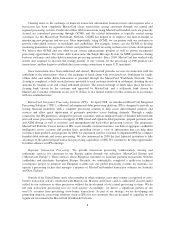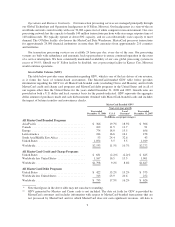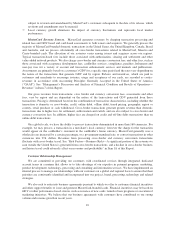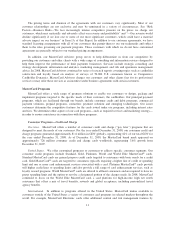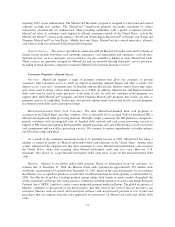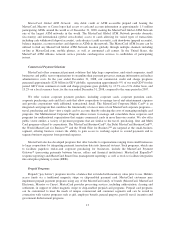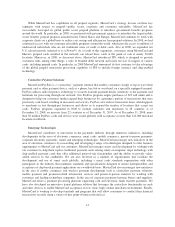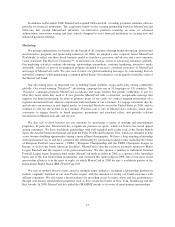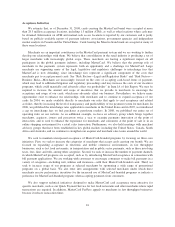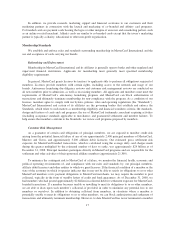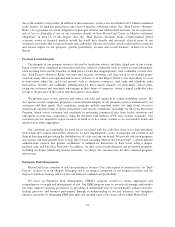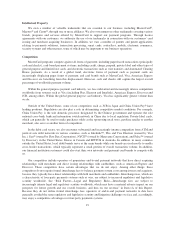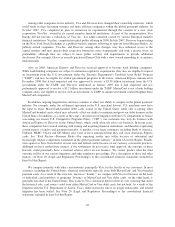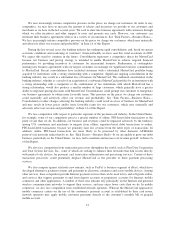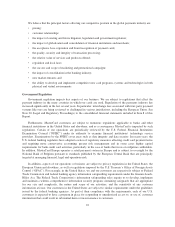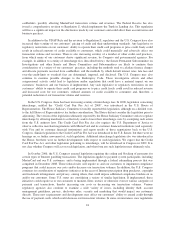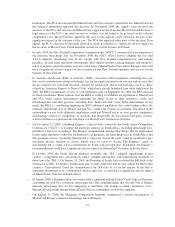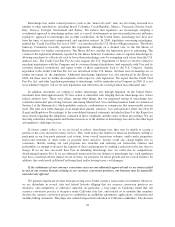MasterCard 2008 Annual Report Download - page 28
Download and view the complete annual report
Please find page 28 of the 2008 MasterCard annual report below. You can navigate through the pages in the report by either clicking on the pages listed below, or by using the keyword search tool below to find specific information within the annual report.due to the member’s risk profile. In addition to these measures, we have also established a $2.5 billion committed
credit facility, for liquidity protection in the event of member settlement failure. See “Risk Factors—Business
Risks—As a guarantor of certain obligations of principal member and affiliate debit licensees, we are exposed to
risk of loss or illiquidity if any of our customers default on their MasterCard, Cirrus or Maestro settlement
obligations” in Item 1A of this Report. See also “Risk Factors—Business Risks—Unprecedented global
economic events in financial markets around the world have directly and adversely affected many of our
customers, merchants that accept our brands and cardholders who use our brands, which could result in a material
and adverse impact on our prospects, growth, profitability, revenue and overall business” in Item 1A of this
Report.
Payment System Integrity
The integrity of our payment system is affected by fraudulent activity and other illegal uses of our system.
Fraud is most often committed in connection with lost, stolen or counterfeit cards or stolen account information,
often resulting from security breaches of third party systems that inappropriately store cardholder account data.
See “Risk Factors—Business Risks—Account data breaches involving card data stored by us or third parties
could adversely affect our reputation and revenue” in Item 1A of this Report. Fraud is also more likely to occur
in transactions where the card is not present, such as electronic commerce, mail order and telephone order
transactions. Security and cardholder authentication for these remote channels are particularly critical issues
facing our customers and merchants who engage in these forms of commerce, where a signed cardholder sales
receipt or the presence of the card or merchant agent is unavailable.
We monitor areas of risk exposure and enforce our rules and standards to combat fraudulent activity. We
also operate several compliance programs to ensure that the integrity of our payment system is maintained by our
customers and their agents. Key compliance programs include merchant audits (for high fraud, excessive
chargebacks and processing of illegal transactions) and security compliance (including our Site Data Protection
Program, which assists customers and merchants in protecting commercial sites from hacker intrusions and
subsequent account data compromises using the Payment Card Industry (PCI) data security standards). Our
customers are also required to report instances of fraud to us in a timely manner so we can monitor trends and
initiate action where appropriate.
Our customers are responsible for fraud losses associated with the cards they issue or for their merchants
from whom they acquire transactions. However, we have implemented a series of programs and systems to aid
them in detecting and preventing the fraudulent use of cards carrying our brands. We provide education programs
and various risk management tools to help detect fraud, including MasterCard SecureCode®, a global Internet
authentication solution that permits cardholders to authenticate themselves to their issuer using a unique,
personal code, and Site Data Protection. In addition, we offer several fraud detection and prevention programs,
including our Expert Monitoring System. Generally, we charge our customers fees for these antifraud programs
and services.
Enterprise Risk Management
MasterCard faces a number of risks in operating its business. For a description of material risks, see “Risk
Factors” in Item 1A of this Report. Managing risk is an integral component of our business activities and the
degree to which we manage risk is vital to our financial condition and profitability.
We have an Enterprise Risk Management (“ERM”) program created to ensure appropriate and
comprehensive oversight and management of risk. Our ERM program aims to: proactively manage and monitor
key risks; improve corporate governance by providing an independent view of our risk profile; enhance decision-
making processes and business performance through an understanding of our risk tolerance; and strengthen
business operations by integrating ERM principles and creating a more risk aware culture within MasterCard.
18


